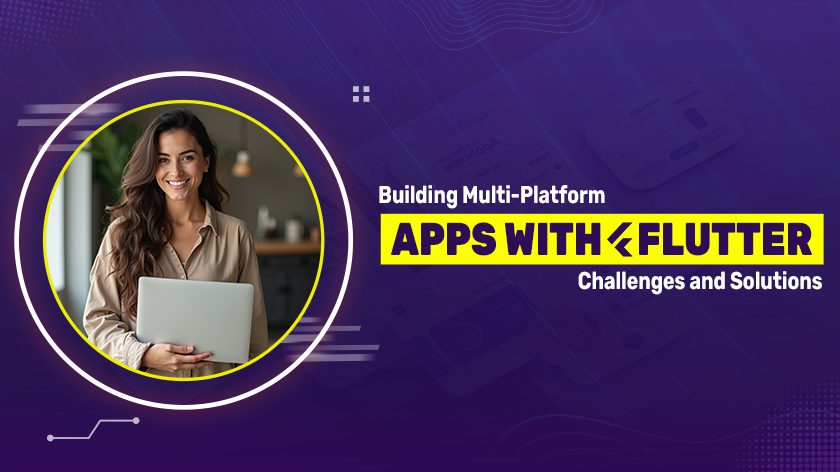One of the most effective frameworks for this purpose is Flutter. This Google-backed, open-source platform enables developers to create natively compiled applications for mobile, web, and desktop from a single codebase. While Flutter offers immense benefits, such as fast development cycles and expressive UI, it is not without its challenges. This blog delves into the challenges developers face when building multi-platform apps with Flutter and provides solutions to overcome them.
1. Platform-Specific UI Adaptations
One of Flutter’s most attractive features is its ability to create a consistent user interface across multiple platforms. However, not all platforms have the same design guidelines. For example, iOS apps require specific design patterns and gestures that differ from Android or web applications.
Solution: Implement Platform-Specific Widgets
Flutter offers platform-specific widgets like Cupertino for iOS and Material for Android. Developers can use conditional logic in the code to render the appropriate UI based on the platform. Additionally, leveraging Flutter’s theme functionality ensures that apps respect the design standards of each platform while maintaining a consistent user experience.
2. Handling Platform-Specific Features
Different platforms have varying hardware, system-level features, and permissions. For instance, integrating push notifications, accessing the camera, or using local storage may work differently on Android, iOS, and web platforms.
Solution: Use Platform Channels and Plugins
Platform channels offered by Flutter let developers run native code written in JavaScript, Swift, or Kotlin. Furthermore, plenty of plugins that hide platform-specific functionality are available from the Flutter community and ecosystem, which enables the integration of these capabilities without needing a new piece of code for every platform.
3. Performance Optimization Across Platforms
While Flutter’s use of a single codebase for multiple platforms boosts development efficiency, it can lead to performance challenges. The app may not run as smoothly across all devices or platforms if not optimized properly.
Solution: Optimize Rendering and Code Execution
To enhance performance, developers should minimize the complexity of widgets and use efficient state management solutions, such as Provider or Bloc. Caching data locally and optimizing network requests can also help ensure that apps perform well across platforms. Profiling tools like Flutter DevTools can be used to analyze and improve performance.
4. App Size Management
Flutter apps can sometimes result in larger app sizes due to the inclusion of Dart libraries, platform-specific assets, and other dependencies. This could be a concern for users who have limited device storage or for businesses aiming to optimize their app download size.
Solution: Reduce Dependencies and Use Lazy Loading
Developers can minimize app size by carefully managing dependencies, removing unnecessary packages, and compressing assets. Implementing lazy loading, where only necessary resources are loaded during app initialization, also helps in reducing the app’s size.
5. Maintaining Consistent User Experience on the Web
While Flutter allows developers to target the web platform, web apps built with Flutter may not behave as expected across all browsers and screen sizes. There can be limitations related to routing, SEO optimization, and browser-specific features.
Solution: Implement Responsive Design and Optimize for Web
Developers may create responsive designs that adjust to the screen size with Flutter’s LayoutBuilder. Optimizing web apps for search engines may be achieved through the use of meta tags, server-side rendering (SSR) techniques, and suitable routing. Testing on an array of browsers is essential to providing a perfect experience.
6. Ensuring Compatibility with Older Devices
Developers often face challenges when running Flutter apps on older Android or iOS devices. Compatibility issues may arise due to outdated hardware, operating systems, or limited resources.
Solution: Set Minimum SDK Requirements and Optimize for Low-End Devices
Setting appropriate minimum SDK versions for Android and iOS ensures that the app runs smoothly on most devices. Additionally, using lightweight widgets, reducing animations, and optimizing image and video assets can make the app more compatible with older devices.
7. Continuous Integration/Continuous Deployment (CI/CD) Issues
Automating the testing, building, and deployment of Flutter apps for multiple platforms can be challenging due to varying environments and requirements. Ensuring a smooth CI/CD pipeline across iOS, Android, and the web may require additional effort.
Solution: Implement Efficient CI/CD lines
Using CI/CD tools like Codemagic, GitHub Actions, or Bitrise, which offer Flutter-specific support, can streamline the development process. These tools help automate testing, building, and deployment across all platforms, ensuring that updates are shipped quickly and efficiently.
Conclusion: Unlock the Full Potential of Multi-Platform Development with Flutter
Building multi-platform apps with Flutter helps businesses maximize reach and streamline development. However, developers face challenges like UI adaptation, platform-specific features, performance optimization, and compatibility. By using Flutter’s ecosystem of widgets, plugins, and performance tools, along with efficient CI/CD pipelines, you can deliver seamless experiences across mobile, web, and desktop platforms.
Are you ready to build fast, efficient, and visually stunning multi-platform apps? Partner with Xceltec’s expert Flutter development team today and elevate your app idea to the next level! Contact us now for a free consultation and see how Xceltec can bring your vision to life!
For more information: https://www.xceltec.com/
 :
https://in.pinterest.com/xceltec0192/
:
https://in.pinterest.com/xceltec0192/












